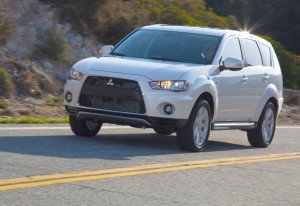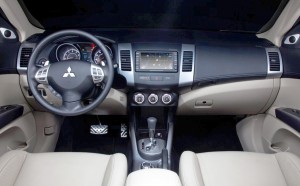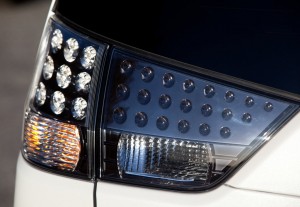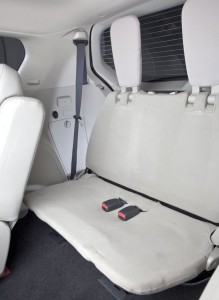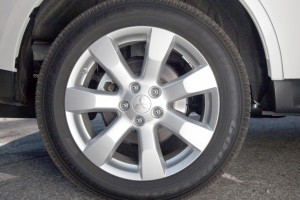Smaller automakers such as Mitsubishi face a challenge competing with the big boys such as Toyota, Honda, Ford and GM.
Do they go after them straight up? Is it smart to try to out Toyota Toyota?
The better tact might be to try something a little bit different. Give an alternative the mainstream, something a bit unusual.
In some ways, that would describe the Mitsubishi Outlander, which went through a mild freshening for 2010.
The Outlander is a small crossover that competes with vehicles such as the Ford Escape, Toyota RAV4 and Chevrolet Equinox. Typical of Mitsubishis, the Outlander is targeted at a younger crowd. As such, the Outlander’s styling, particularly inside, is edgier than others that play in this segment.
As one might expect with a vehicle aimed at younger folks, the Outlander has an attractive base price, $21,605 including destination. But the options add up quickly. The GT tested here with an advanced version of Mitsubishi’s all-wheel drive system, V-6 and the third row seat, starts at $29,990. Add in the test vehicle’s leather and navigation package ($3,000) for an out-the-door price of $32,990.
The major element of the makeover is the Outlander’s new prow, which was largely lifted from Mitsubishi’s most successful model, the Lancer small sedan. Mitsubishi calls it a “jet fighter grille.” OK, but most airplanes, especially jet fighters, have very pointy snouts. Then again, “slightly forward-leaning trapozoid-shaped grille” isn’t quite as exciting. And besides, automakers pointing out their aircraft lineage is sort of de rigueur (Remember, Saabs were born from jets and the coveted BMW roundel is a spinning propeller) these days. Anyway, the Outlander’s version of Mitsubishi’s new corporate face doesn’t work as well as it does on the Lancer.
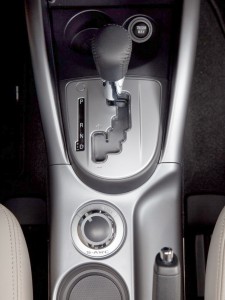
The Mitsubishi Outlander's all-wheel drive system has a knob to choose between settings for tarmac, snow and lock.
Outlanders come standard with front-wheel drive and a double-overhead cam 2.4-liter, 168-horsepower four cylinder connected to a continuously variable transmission (CVT) in ES and SE models. Opt for the up-level XLS or GT models and you get a single-overhead cam 3.0-liter V-6 making 230 horsepower, up 10 hp from last year’s model. The V-6 is connected to a slick-shifting six-speed automatic with manumatic shifting. The XLS is available as a front-driver or with a traditional all-wheel drive system with settings for front-wheel drive, four-wheel drive and lock.
Five seats are standard, but a third row with seating for two is available on the SE and standard on V-6 models. A third row in a small SUV makes some sense – Toyota makes it work in the RAV4 – but Mitsubishi’s is not useful. The flimsy seat pops out of a shallow well in the cargo area. It’s very thinly padded and is uninhabitable by adults. In fact, this third row should only been seen as an occasional seat, such as a child’s friend coming over for a slumber party. Tell them to sit on their pillow so the seat’s metal frame doesn’t leave their backsides sore.
Things are better in the front row, where the driver and passenger have expansive space, even with the sunroof that is standard on the GT tested here. The Outlander’s front seats are comfortable and offer decent lateral support. There’s good storage, including a double glovebox for the passenger. The gauges are easy to read and all of the controls fall readily to hand.
The 60/40 split middle row is not as comfortable and offers limited headroom compared to others in the segment. The seats slide forward, but most adults will want to have the seats in their aft position. Some vehicles have second-row seats that slide all the way against the seatbacks, making it easier for a parent to reach a child in a car seat, but the Outlander’s do not go that far. The seat cushion is relatively flat and oddly shaped, giving the feeling that the you’re going to slide off of it. At least the smaller side of the seat flips forward easily to offer access to the third-row mini seats. At least those consigned to third row will have an easy time getting back there.
Some of the secondary controls, such as those for the HVAC system, do not have the quality tactile feel that has become so commonplace, even among inexpensive cars.
But there’s no such complaint about the car’s primary controls – steering, gearshift, brakes and throttle. On the important stuff, the Outlander scores well. One surprise was that the hood tends to quiver when negotiating Southeast Michigan’s cratered road surfaces.
The V-6 engine is somewhat coarse, which is surprising since Mitsubishi holds the patent on balance shafts, which many automakers use to quell harshness in their own four- and six-cylinder engines. Engine power is sufficient, but certainly no where near best in class. On the flip side, fuel economy isn’t as good as some of the best fuel mizers. For example, the RAV4 is available with a fire-breathing 269-horsepower V-6, yet is rated at 19 city and 26 highway. The Outlander is rated at 18/24.
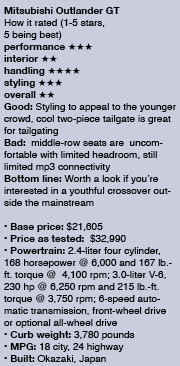 The Outlander handles well, at least as well as one could expect of what is essentially a station wagon on stilts. In a perfect world, people who need more cargo capacity than a typical car trunk would drive wagons. OK, time to get off the soapbox.
The Outlander handles well, at least as well as one could expect of what is essentially a station wagon on stilts. In a perfect world, people who need more cargo capacity than a typical car trunk would drive wagons. OK, time to get off the soapbox.
The GT’s S-AWC includes an active front differential and a locking center differential to help direct power to the wheels that have the most traction. There’s a knob with settings for tarmac, snow and lock. There was no opportunity to try it out on snow at the time of year I drove it. The Outlander is not really designed for serious off-road exploration, so the lock setting would probably be best suited for extremely snowy conditions or to get the vehicle unstuck.
On the road, the all-wheel-drive system provides excellent grip and zero torque steer.
One of the Outlander’s best features is its split tailgate. After raising the hatchback, lift a lever to lower the small tailgate. It’s rated to hold 440 pounds, making it the perfect perch to watch a kid’s soccer game if the weather’s a little wet. It also allows easy access to the 36.2 cubic feet of cargo space behind the middle row (with the third-row seat folded). Cargo space expands to 72.6 cubic feet with the middle row folded.
The thumping bass from the 710-watt Rockford Fosgate stereo and it’s massive subwoofer mounted in the cargo area is sure to impress the Outlander’s target audience, but the lack of a USB or at least an 3.5mm input jack for mp3 players is shocking, although there are RCA input jacks. Connections for digital music players are missing across Mitsubishi’s line, an appalling omission for a company that caters to people who consider their mp3 player as important an accessory as shoes.
Besides that surprising demerit, the stereo will certainly impress those who like to share their music with the outside world. To dial up maximum bass, turn up the stereo’s “punch” setting to really rock it out. The sound is somewhat coarse, but it will get the car a rockin’.
Really, that’s what Mitsubishis are all about. They’re built to appeal to those who haven’t yet come to appreciate the most refined implements.
Mitsubishi has promised that it is committed to the U.S. market, despite severely depressed sales. To regain the ground it has lost, the triple-diamond brand is simply going to have to buy better cars.
Bryan Laviolette is an automotive critic and contributor to MLive.com. He also runs the Michigan wllz Web site. Contact him at laviolette.autoscribe@yahoo.com.

